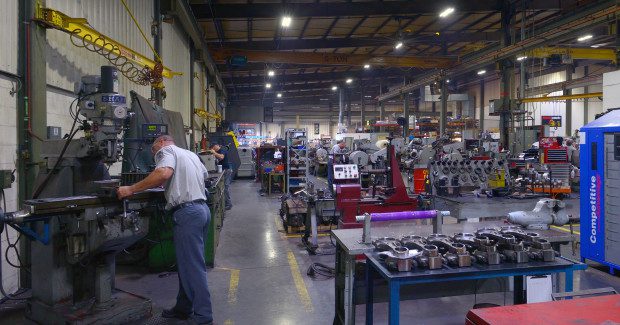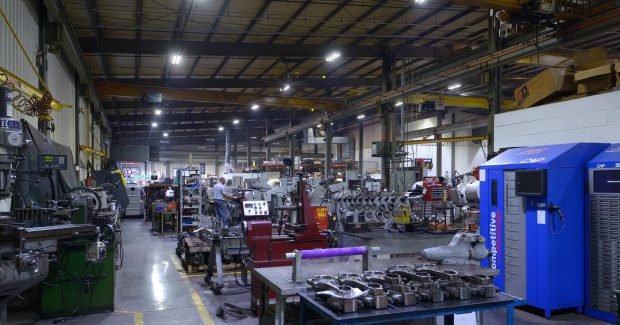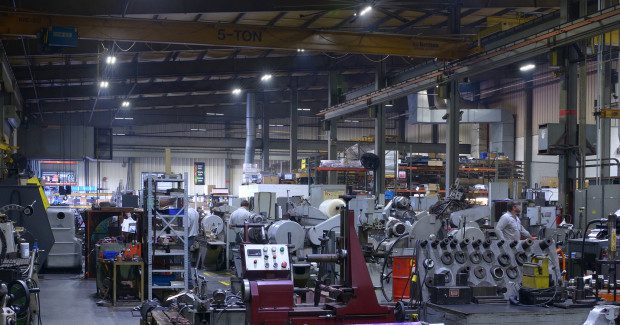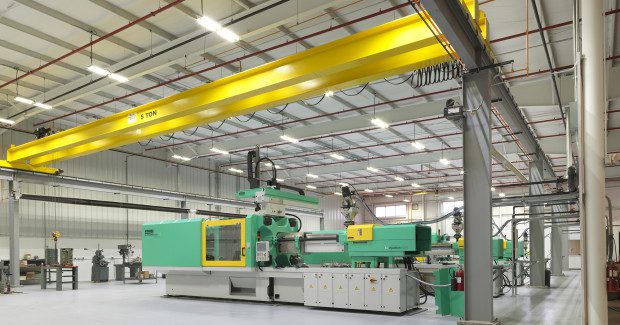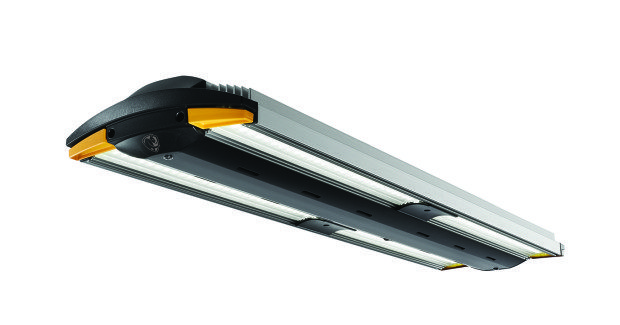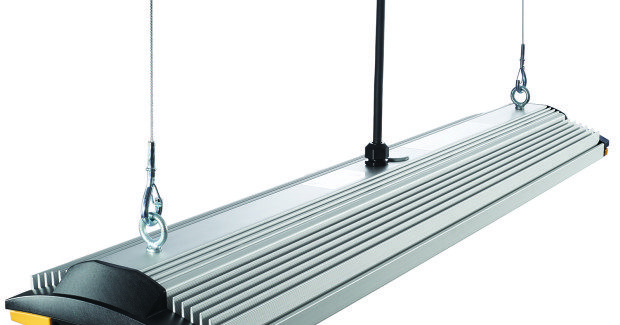To LED or Not to LED?
When deciding whether LEDs are a fit for your shop, take a moment to set the energy-efficiency debate aside and consider these factors.
Posted: September 7, 2015
Yes, it’s a question that faced Northern Metal Fab, Inc. (Baldwin, WI), a job shop that manufactures light-to-heavy weldments, prototypes and other piece parts where maintaining metal halide and fluorescent lights became a maddening cycle. “It felt like chasing our own tails,” said Jay Burton, a purchasing agent at Northern Metal Fab. With only two maintenance employees, the process of re-lamping and fixing lights was constant and cutting into other important duties, such as keeping an eye on their automated heavy duty flexible manufacturing system that is married to a 4 kW laser burn table, or their fully integrated precision press brakes.
The maintenance technicians would start swapping bulbs and ballasts at one end of the 80,000 sq ft building, but by the time they finished the fixtures would need attention again. That prompted the company to begin a two-year phase-in of BAL-HBL1 High Bay LED lights from Big Ass Solutions (Lexington, KY) that have a rated life of up to 150,000 hours with little maintenance. The reduction in upkeep was the primary selling point, but an added benefit was energy savings – about $10,000 for the shop in the first year.
https://youtu.be/KFDfrlgqBC4
Widely touted as the most energy-efficient lighting on the market, LEDs offer more than smaller utility bills. However, it turns out that LEDs aren’t always the most cost-effective lighting solution for facilities. When deciding whether LEDs are a fit for your shop, take a moment to set the energy-efficiency debate aside and consider the following pros and cons:
PROS
- Long Life – High-end LEDs are rated for up to 150,000 hours of use, which amounts to about 17 years if used 24/7 annually.
- Low Maintenance – There are no bulbs or ballasts to replace. Rather than blowing out like standard bulbs, LEDs experience lumen depreciation, a long process that takes a decade or more.
- Directional Light – All light produced by LEDs is directed to the floor. Comparatively, much of the light from metal halides and fluorescents is wasted since it is directed at the ceilings and walls.
- Durability – LEDs are far more impact-resistant than glass bulbs.
CONS
- Upfront Cost – LEDs cost about twice as much as older-style metal halide or fluorescent fixtures.
- Hard-to-Judge Brightness – Old standards, such as wattage and fixture size, no longer equate to brightness. Facilities that swap fixtures one-to-one can easily wind up with distractingly bright or dark spaces.
- Potentially Long ROI – LEDs are only five percent to ten percent more energy-efficient than cutting-edge fluorescents, which can create a longer-than-expected return on investment. However, LEDs are always a sure bet when replacing metal halides, which use twice as much energy.
- Incompatibility – Some fixtures don’t work well with existing grids and controls, which requires the help of certified installers and electricians.
With a minefield of pros and cons, why were LEDs the right choice for Northern Metal Fab? For starters, consider the product. The BAL-HBL1 High Bay LED light is one of the only LED fixtures designed from the ground up for industrial facilities. The anodized, extruded aluminum housing was built for durability, but it also acts as a heat sink, dispersing warmth that would otherwise cause the diodes to degrade more quickly. Easy-access panels allow for quick upgrades, and swappable lumen maintenance trays disperse light as well as protect diodes from dust and debris.
Additionally, several unique facility features and operations made LEDs the right solution for Northern Metal Fab. Other managers should consider whether these same conditions exist at their facilities before deciding whether to upgrade:
- Metal Halides – Northern Metal Fab used inefficient metal halides, which pull twice the wattage of LEDs. Despite the cost of high-quality LED fixtures, the ROI is only expected to be about two to three years.
- Energy Rebates – Rebate amounts vary by utility company and region. The utility company used by Northern Metal Fab offered rebates of about $60 per fixture – totaling $6,000 for phase one alone – to companies upgrading to more energy-efficient lighting.
- High Ceilings – The directed light from LEDs is more efficient, but if there’s not enough room to spread, the beams can appear narrow. The Northern Metal Fab plant has 25 ft ceilings, an ideal height for 20,000 lumen LED fixtures.
- Flexible Budget – To even out the cost (and labor) of a facility-wide upgrade, Northern Metal Fab worked with Big Ass Solutions to phase-in LEDs over the course of two years.
- Sustainable Mindset – Northern Metal Fab was already focused on waste-reduction initiatives when managers decided to switch to more energy-efficient LEDs, making the purchase easier to justify.
- Not A Packed House – At Northern Metal Fab, not every piece of equipment is running and not every production area is occupied at all times. The shop saves even more on energy because Big Ass Light occupancy sensors turn the LEDs on and off automatically.
- Educated Management – Managers at Northern Metal Fab learned how light output differs between fluorescents, metal halides and LEDs. They realized one-to-one replacement was not the ideal solution, so they worked with Big Ass Light to develop a custom layout for maximum brightness with minimal fixtures.
Northern Metal Fab is not the only metalworking shop to benefit from LEDs. Outside of energy and cost savings, the top selling point for most machinists is brightness. The detailed and technical work involved in machining can easily be enhanced with a bright, direct light source. For example, Atlas Machine & Supply, Inc. (Louisville, KY), replaced all of its old fluorescent fixtures with LEDs from Big Ass Solutions. The fluorescents were so dim and poorly placed that their machinists struggled to read technical documents. Even though the shop reduced its total number of fixtures by about half, the LEDs nearly tripled lighting levels from about 12 foot candles to 30 foot candles.
https://youtu.be/z9AedVEUrRw
Another example is American Alloy Steel Inc. (Houston, TX), which attached two High Bay LEDs from Big Ass Solutions to an overhead crane, replacing wasteful metal halides. Prior to installation, associates needed flashlights to make sure they were selecting the right piece of steel to hoist. After installation, they could easily read stamps and color codes, improving productivity. Shop managers that are considering LED upgrades should enlist the help of a company with engineers, designers, electricians and installers on staff. These experts can help traverse the potential pitfalls and determine whether LED lighting is the best possible solution.
Northern Metal Fab, Inc., 500 Evergreen Street, Baldwin, WI 54002, 715-684-3535, Fax: 715-684-3639, www.nmfinc.com.
Atlas Machine & Supply, Inc., 7000 Global Drive, Louisville, KY 40258, 502-584-7262, Fax: 502-589-0310, www.atlasmachine.com.
American Alloy Steel Inc., 6230 N Houston Rosslyn Road, Houston, TX 77091, 713-462-8081, www.aasteel.com.
Big Ass Solutions, 2348 Innovation Drive, Lexington, KY 40511, 877-244-3267, www.bigasssolutions.com.





